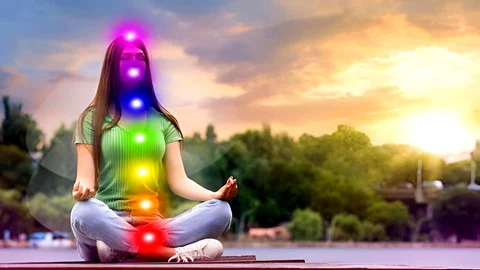Unlock Inner Balance: Your Complete Chakra Meditation Guide
Discover how chakra meditation: complete can transform your well-being. If your self-care routine is missing—here's the powerful practice to integrate for profound balance and vitality.

Are you feeling a persistent sense of imbalance, wondering what your self-care routine is missing—here's a compelling answer: chakra meditation: complete for holistic wellness. This ancient practice, gaining renewed attention in 2025 for its profound benefits, offers a pathway to unlock your body's innate energy centers. By focusing on these vital points, individuals can achieve deeper mental clarity, emotional stability, and physical vitality, transforming their daily lives.
Introduction to Chakra Meditation: Complete Holistic Wellness
Chakra meditation is a profound spiritual practice originating from ancient Indian yogic traditions, dating back millennia. The term “chakra,” derived from Sanskrit, signifies a “wheel” or “disc,” referring to the seven invisible energy centers believed to reside along the spine, from its base to the crown of the head. While not scientifically recognized in a physiological sense, these chakras are understood within the belief system as vibrant hubs influencing various aspects of our physical, emotional, and spiritual health. Karla Helbert, an internationally certified yoga therapist, emphasizes that this practice helps individuals feel more grounded, centered, and peaceful.
An imbalance or blockage in any of these energy centers is thought to manifest as physical discomfort or emotional distress. Chakra meditation: complete aims to realign these centers, fostering a harmonious flow of energy that can significantly enhance overall well-being. This practice is particularly effective for those seeking a deeper connection to their inner self and a more robust self-care routine missing—here's an opportunity to integrate ancient wisdom into modern life.
The Science Behind Energy Centers and Well-being
While the concept of chakras is rooted in spiritual traditions, the practice of meditation itself has extensive scientific backing. Recent studies (Harvard, 2024) indicate that mindfulness and focused meditation can alter brain structures related to self-awareness and emotion regulation. Focused attention, a core component of chakra meditation, has been shown to reduce stress hormones and improve cognitive functions.
The visualization techniques used in chakra meditation engage the brain's creative and imaginative centers, potentially influencing mood and perception. Research on similar mind-body practices suggests a positive impact on the autonomic nervous system, promoting relaxation and reducing the body's 'fight or flight' response (Stanford researchers, 2023). This holistic approach recognizes the intricate connection between mind and body.
When we consciously direct our attention and intention to specific areas, as in chakra work, we engage neural pathways that can foster a sense of balance and calm. It's not about physically 'unblocking' an energy wheel, but rather using the chakra system as a metaphorical framework to address psychological and emotional states, thereby improving the entire self-care routine missing—here's a powerful tool for self-exploration.
Exploring the Seven Chakras: Your Body's Energy Map
Understanding each chakra is fundamental to effective meditation. Each center is associated with specific colors, locations, and life functions. Imbalances in these areas can impact various aspects of your life:
- Root Chakra (Muladhara): Located at the base of the spine, associated with red. Governs stability, security, and basic needs. Imbalances can lead to feelings of fear or insecurity.
- Sacral Chakra (Svadhisthana): Situated in the lower abdomen, linked to orange. Controls creativity, passion, and emotional well-being. Blocks may result in creative stagnation or dependency issues.
- Solar Plexus Chakra (Manipura): Found in the upper abdomen, represented by yellow. Influences confidence, willpower, and personal power. Imbalances can manifest as low self-esteem or digestive problems.
- Heart Chakra (Anahata): In the center of the chest, associated with green or pink. The hub of love, compassion, and forgiveness. Blockages can affect relationships or empathy.
- Throat Chakra (Vishuddha): Located in the throat area, linked to blue. Governs communication, truth, and self-expression. Imbalances may cause difficulty speaking one's truth or physical throat issues.
- Third Eye Chakra (Ajna): Positioned between the brows, represented by indigo. The center of intuition, insight, and spiritual awareness. Blocks can lead to lack of clarity or headaches.
- Crown Chakra (Sahasrara): At the top of the head, associated with violet or white. Connects to spirituality, divine consciousness, and enlightenment. Imbalances might result in depression or a loss of purpose.
Research-Backed Benefits of Balancing Your Chakras
Integrating chakra meditation: complete into your lifestyle can yield a multitude of benefits, supported by broader meditation research. A 2019 study, for instance, found that regular chakrayoga meditation led to greater mindfulness, lower stress, and improved well-being, highlighting its holistic impact.
- Stress Reduction: A primary benefit, chakra focus provides a structured way to quiet the mind, leading to lower anxiety and stress levels. The calming effect helps regulate the nervous system.
- Enhanced Self-Awareness: By systematically focusing on different energy centers, practitioners engage in deep introspection, observing thoughts and emotions linked to each chakra. This process significantly boosts self-understanding and emotional intelligence.
- Improved Concentration: The sustained attention required to visualize and focus on each chakra strengthens cognitive faculties, enhancing overall focus and attention span in daily tasks (Harvard, 2024).
- Promotes Positivity & Emotional Balance: The use of specific colors and affirmations associated with each chakra can foster a more optimistic outlook and greater emotional resilience. For example, focusing on the Heart Chakra cultivates compassion, while the Solar Plexus boosts confidence.
- Increased Energy Levels: Many individuals report feeling refreshed and energized after chakra meditation, attributing it to the perceived 'clearing' or 'activation' of energy pathways.
- Spiritual Growth: For those on a spiritual journey, this practice offers a framework for exploring higher states of consciousness and deepening one's connection to universal energy.
- Better Sleep Quality: The relaxation induced by consistent meditation practices, including chakra work, is widely known to improve sleep patterns, helping individuals fall asleep faster and experience more restful nights.
Practical Steps for Your Chakra Meditation Practice
To begin your journey with chakra meditation: complete, preparation is key. This transforms your practice from a simple exercise into a powerful ritual for your self-care routine missing—here's how to set the stage and follow a guided approach:
Preparation for Meditation:
- Select a Quiet Space: Choose a peaceful, undisturbed area. This could be a corner of your room, a quiet garden, or any space where you can be alone.
- Dress Comfortably: Opt for loose, breathable clothing that won't restrict movement or focus.
- Gather Props: Cushions or bolsters can enhance comfort, especially for longer sessions. A blanket can be useful if you tend to get cold.
- Set the Ambiance: Dim the lights, light a candle, or use an essential oil diffuser with calming scents like lavender or frankincense to deepen relaxation.
- Choose Calming Sounds: Soft instrumental music, nature sounds, or binaural beats can help you relax without distraction.
- Silence Devices: Ensure all electronic devices are off or on silent mode to prevent interruptions.
Step-by-Step Guided Chakra Meditation:
- Assume a Comfortable Position: Lie on your back or sit cross-legged with a straight spine. Adjust as needed until you feel completely at ease.
- Close Your Eyes & Deep Breaths: Gently close your eyes and begin with several deep, slow breaths. Focus on the sensation of your breath entering and leaving your body.
- Root Chakra (Red): Bring your attention to the base of your spine. Visualize a vibrant red light, feeling deeply grounded and secure. Affirm: “I am safe and stable.”
- Sacral Chakra (Orange): Move your awareness to your lower abdomen. Picture a warm, glowing orange light, embracing creativity and emotional flow. Affirm: “My creativity flows freely.”
- Solar Plexus Chakra (Yellow): Shift focus to your upper abdomen. Envision a bright yellow light, radiating confidence and personal power. Affirm: “I am strong and confident.”
- Heart Chakra (Green/Pink): Direct attention to the center of your chest. Visualize a gentle green or pink light, expanding with love, compassion, and forgiveness. Affirm: “I give and receive love effortlessly.”
- Throat Chakra (Blue): Focus on your throat. Imagine a clear blue light, symbolizing honest and clear communication. Affirm: “I speak my truth with clarity.”
- Third Eye Chakra (Indigo): Bring your awareness to your forehead, between your brows. Picture a deep indigo light, enhancing intuition and insight. Affirm: “I trust my inner wisdom.”
- Crown Chakra (Violet/White): Finally, focus on the top of your head. Visualize a radiant violet or white light, connecting you to higher consciousness and spiritual enlightenment. Affirm: “I am connected to the divine.”
- Chakra Alignment: Picture all seven chakras glowing brightly and spinning in perfect harmony, a vibrant column of energy flowing through your entire body.
- Body Scan & Return: Gently scan your body for any lingering tension, breathing into those areas. When ready, slowly bring your awareness back to the present, open your eyes, and gently move.
- Reflect: Take a few moments to journal any insights or sensations experienced during your meditation. This helps integrate the practice.
Deepening Your Self-Care Through Chakra Alignment
To truly integrate chakra meditation into your life and ensure it's not a self-care routine missing—here's a commitment to consistency and exploration. Elevating your practice can amplify its benefits:
- Consistency is Key: Dedicate a specific time each day, even if just for 5-10 minutes. Morning sessions can energize, while evening practices promote restful sleep. The best time is simply your time.
- Extend Your Sessions Gradually: Start short and increase duration as comfort grows. Longer weekend sessions can allow for deeper exploration.
- Incorporate Affirmations: As mentioned in the step-by-step guide, using chakra-specific affirmations reinforces positive intentions and beliefs, strengthening the energetic connection.
- Experiment with Mudras: These symbolic hand gestures can further focus energy and enhance the meditative state. Each chakra has a corresponding mudra that can be practiced during its specific visualization.
- Journaling for Insight: Maintaining a meditation journal helps track progress, identify recurring themes, and deepen self-awareness over time. It's an excellent way to consolidate insights.
- Explore Sound Healing: Integrate singing bowls or specific frequency music tuned to each chakra. Sound vibrations can help stimulate and balance energy centers, adding another sensory layer to your practice.
- Consider Expert Guidance: As Karla Helbert advises, attending workshops or working with an experienced meditation teacher can provide personalized insights and advanced techniques.
By embracing these strategies, your chakra meditation: complete practice will evolve, providing a powerful foundation for ongoing self-care and holistic well-being in 2025 and beyond.
3 Sources:
- Van't Westeinde A, Patel KD. Heartfulness meditation: a yogic and neuroscientific perspective.Front Psychol. 2022;13:806131. doi:10.3389/fpsyg.2022.806131
- Maxwell RW, Katyal S. Characteristics of Kundalini-related sensory, motor, and affective experiences during tantric yoga meditation.Front Psychol.2022;13:863091. doi:10.3389/fpsyg.2022.863091
- Cho YJ, Sim KL, Cho SJ, et al. Effectiveness of training program combining chakrayoga and meditation.J Complement Integr Med. 2019 doi:10.1515/jcim-2018-0167
About Ava Thompson
NASM-certified trainer and nutrition nerd who translates science into simple routines.
View all articles by Ava Thompson →Our content meets rigorous standards for accuracy, evidence-based research, and ethical guidelines. Learn more about our editorial process .
Get Weekly Insights
Join 10,000+ readers receiving actionable tips every Sunday.



